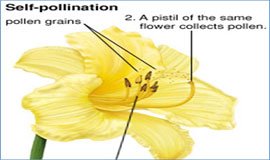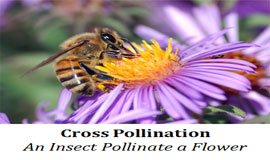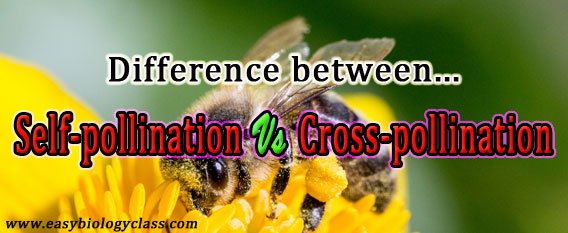Pollination is a process in sexual reproducing plants by which the pollen grains from the anther is transferred to the stigma of the gynoecium and thereby enable fertilization. Pollination is an essential step for sexual reproduction in seed plants (Spermatophytes – Gymnosperms and Angiosperms) to produce the seeds. In plants (typically in Angiosperms), the pollination and the completion of sexual reproduction can be achieved by two methods – Self pollination and Cross pollination. This post summarizes the Similarites and Difference between Self Pollination and Cross Pollination.
Self-pollination: Pollen from the anther of a flower is deposited on the stigma of the same flower or a different flower of the same plant.
Cross-pollination: Pollen from the anther of a flower is deposited on the stigma of a flower borne on another plant of the same species.
Nature favor cross-pollination since, it enables a better chance for creating variability in the progenies.
Moreover, in order to prevent self-pollination, plants have evolved several structural and genetic methods such as the production of unisexual flowers, the positioning of male and female parts to avoid self-pollination, self-incompatibility and maturation of male and female parts in different types (protandry and protogyny).
Difference between Self pollination and Cross Pollination
Sl. No. Self-Pollination Cross-Pollination
1 Pollen from the anther of a flower is deposited on the stigma of the same flower. Pollen from the anther is deposited on the stigma of a flower produced on another plant.


2 It may be autogamy* or geitonogamy*. It will be always allogamy*.
3 In self-pollinating plants, anther and stigma mature at the same time. In cross pollinating plants anther and stigma mature at different times.
4 Self-pollination can occur even when the flowers are in closed condition (cleistogamy*). In order to facilitate cross pollination, the flower should open first.
5 The pollinator* is not required for self-pollination. The help of a pollinator is always required to establish the cross-pollination.
6 Self-pollination is economical to the plants. Cross pollination is not economical to the plant. To ensure cross pollination, the plant has to produce more flowers, pollen grains and nectar.
7 Self-pollination causes homogenous condition in progenies. Cross pollination cause heterozygous condition in progenies.
8 Self-pollination causes inbreeding*. Cross-pollination causes outbreeding*.
9 The progenies of self-pollination will be more or less genetically similar to the parent plant. The progenies of cross pollination will be genetically different from the parent.
10 Chance of creating variability is very less. Chance or creating variability is more.
11 Cannot eliminate unwanted or harmful characters from plants. Can eliminate unwanted and harmful characters.
12 With self-pollination highly useful characters get preserved in the race. Cross pollination can result in the loss of useful characters in the progeny due to genetic segregation.
13 Adaptability of progenies towards the changing environmental conditions is very less. Adaptability of progenies will be more due to the high variability.
14 Immunity of the race towards disease falls in successive generations. The immunity towards a disease will increase in successive generations.
15 Plant yield will fall with time. Plant yield doesn’t fall with time.
16 Self-pollination never helps to produce new variety or new species. Cross pollination produce new varieties and new species.
17 No evolutionary significance in the population. Have high evolutionary significance.
18 Pure-line selection method is used to breed a plant with self-pollination. Mass selection method is used to breed a plant with cross-pollination.
*Autogamy: Pollen from the anther is deposited on stigma of same flower.
*Geitonogamy: Pollen from an anther is deposited on the stigma of a separate flower borne on the same plant.
*Allogamy: Pollen from the anther is deposited on the stigma of flower borne on a different plant of same species.
*Cleistogamy: An adaptation to self-pollination in which the pollination occurs before the flower opens.
*Pollinator: An external agency which facilitate the pollination process. (Example: Insects, birds, wind, water flower etc.)
*Inbreeding: Matting of closely related individuals, results in homozygosity and which leads to inbreeding depression.
*Outbreeding: matting of genetically unrelated individuals, results in heterozygosity and which leads heterosis.
| You may also like... | ||
|---|---|---|
| NOTES | QUESTION BANK | COMPETITIVE EXAMS. |
| PPTs | UNIVERSITY EXAMS | DIFFERENCE BETWEEN.. |
| MCQs | PLUS ONE BIOLOGY | NEWS & JOBS |
| MOCK TESTS | PLUS TWO BIOLOGY | PRACTICAL |
You might also like…
@. Difference between Asexual and Sexual Reproduction
@. Difference between Flower and Vegetative Shoot

